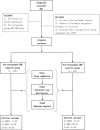Clinical characteristics and prognostic value of pre-retreatment plasma epstein-barr virus DNA in locoregional recurrent nasopharyngeal carcinoma
- PMID: 31268626
- PMCID: PMC6712460
- DOI: 10.1002/cam4.2339
Clinical characteristics and prognostic value of pre-retreatment plasma epstein-barr virus DNA in locoregional recurrent nasopharyngeal carcinoma
Abstract
Purpose: To define the clinical characteristics and prognostic value of pre-retreatment plasma Epstein-Barr virus (EBV) DNA, we investigated EBV status in locoregional recurrent nasopharyngeal carcinoma (lrNPC) patients.
Methods: Between April 2008 and August 2016, the data of patients with nonmetastatic lrNPC were retrospectively reviewed. The survival indexes of patients between different pre-retreatment EBV status groups were compared.
Results: A total of 401 patients with nonmetastatic lrNPC were enrolled, and 197 (49.1%) patients had detectable pre-retreatment plasma EBV DNA. Treatment included radiotherapy alone (n = 37 patients), surgery alone (n = 105), radiotherapy (n = 208), surgery combined with radiotherapy (n = 20), chemotherapy and targeted therapy (n = 31). Median follow-up was 32 months. The 3-year locoregional relapse-free survival (LRRFS), distant metastasis-free survival (DMFS), and overall survival (OS) rates for the entire cohort were 64.8%, 89.4%, and 58.8%, respectively. The estimated 3-year LRRFS, DMFS, and OS rates for the pre EBV-positive group vs the pre EBV-negative group were 54.2% vs 75.0% (P < 0.001), 86.6% vs 91.9% (P = 0.05), 51.6% vs 65.9% (P = 0.01), respectively. Among patients in the clinical stage rI/II, there were 17 patients in the radiotherapy alone group and 49 patients in the surgery alone group. And there was no significant difference in overall survival between radiotherapy and surgery, even among the different pre-EBV statuses (P > 0.05). In terms of long-term toxic and side effects, the incidence of radioactive temporal lobe injury in the radiotherapy group was higher than that in the surgery group (35.3% vs 8.2%, P < 0.001), and no statistically significant difference was found in other long-term toxic and side effects.
Conclusions: The positive rate of pre-retreatment plasma EBV DNA in lrNPC is lower than primary NPC. The prognosis of EBV DNA negative group is better than positive group. For locally early-stage lrNPC, regardless of EBV DNA status, radiotherapy and surgery are available options and both can achieve better long-term survival.
Keywords: Epstein-Barr Virus DNA; clinical characteristics; prognostic; recurrent nasopharynx.
© 2019 The Authors. Cancer Medicine published by John Wiley & Sons Ltd.
Figures




Similar articles
-
Prognostic value of gross tumor regression and plasma Epstein Barr Virus DNA levels at the end of intensity-modulated radiation therapy in patients with nasopharyngeal carcinoma.Radiother Oncol. 2019 Mar;132:223-229. doi: 10.1016/j.radonc.2018.10.010. Epub 2018 Oct 23. Radiother Oncol. 2019. PMID: 30366725
-
The diagnostic and prognostic values of plasma Epstein-Barr virus DNA for residual cervical lymphadenopathy in nasopharyngeal carcinoma patients: a retrospective study.Cancer Commun (Lond). 2019 Mar 29;39(1):14. doi: 10.1186/s40880-019-0357-9. Cancer Commun (Lond). 2019. PMID: 30925939 Free PMC article.
-
Survival analysis of patients with advanced-stage nasopharyngeal carcinoma according to the Epstein-Barr virus status.Oncotarget. 2016 Apr 26;7(17):24208-16. doi: 10.18632/oncotarget.8144. Oncotarget. 2016. PMID: 27008701 Free PMC article.
-
Prognostic value of Epstein-Barr virus DNA level for nasopharyngeal carcinoma: a meta-analysis of 8128 cases.Eur Arch Otorhinolaryngol. 2020 Jan;277(1):9-18. doi: 10.1007/s00405-019-05699-9. Epub 2019 Oct 28. Eur Arch Otorhinolaryngol. 2020. PMID: 31659449 Review.
-
The clinical utility of plasma Epstein-Barr virus DNA assays in nasopharyngeal carcinoma: the dawn of a new era?: a systematic review and meta-analysis of 7836 cases.Medicine (Baltimore). 2015 May;94(20):e845. doi: 10.1097/MD.0000000000000845. Medicine (Baltimore). 2015. PMID: 25997061 Free PMC article.
Cited by
-
Prognostic factors in metastatic nasopharyngeal carcinoma.Braz J Otorhinolaryngol. 2022 Mar-Apr;88(2):212-219. doi: 10.1016/j.bjorl.2020.05.022. Epub 2020 Jul 4. Braz J Otorhinolaryngol. 2022. PMID: 32690385 Free PMC article.
-
Retreatment in locally recurrent nasopharyngeal carcinoma: Current status and perspectives.Cancer Commun (Lond). 2021 May;41(5):361-370. doi: 10.1002/cac2.12159. Epub 2021 May 6. Cancer Commun (Lond). 2021. PMID: 33955719 Free PMC article. No abstract available.
-
Prognostic value of Epstein-Barr virus DNA load in nasopharyngeal carcinoma: a meta-analysis.Pan Afr Med J. 2022 Jan 3;41:6. doi: 10.11604/pamj.2022.41.6.28946. eCollection 2022. Pan Afr Med J. 2022. PMID: 35145598 Free PMC article. Review.
-
Effects of oral maintenance chemotherapy and predictive value of circulating EBV DNA in metastatic nasopharyngeal carcinoma.Cancer Med. 2020 Apr;9(8):2732-2741. doi: 10.1002/cam4.2926. Epub 2020 Feb 23. Cancer Med. 2020. PMID: 32090498 Free PMC article.
-
Anti-epidermal growth factor receptor monoclonal antibody plus palliative chemotherapy as a first-line treatment for recurrent or metastatic nasopharyngeal carcinoma.Cancer Med. 2020 Mar;9(5):1721-1732. doi: 10.1002/cam4.2838. Epub 2020 Jan 19. Cancer Med. 2020. PMID: 31955525 Free PMC article. Clinical Trial.
References
-
- Torre LA, Bray F, Siegel RL, Ferlay J, Lortet‐Tieulent J, Jemal A. Global cancer statistics, 2012. CA Cancer J Clin. 2015;65(2):87‐108. - PubMed
-
- Chua ML, Chan AT. Gemcitabine: a game changer in nasopharyngeal carcinoma. Lancet. 2016;388(10054):1853‐1854. - PubMed
-
- Lee A, Ma B, Ng WT, Chan A. Management of nasopharyngeal carcinoma: current practice and future perspective. J Clin Oncol. 2015;33(29):3356‐3364. - PubMed
-
- Sun Z, Xiao C, Jiang W, Feng X, Liu Y. Comparison of Epstein‐Barr virus in nasopharynx tissue and desquamatine cell for diagnosis of nasopharyngeal carcinoma. Lin Chuang Er Bi Yan Hou Ke Za Zhi. 2006;20(4):153‐154. - PubMed
Publication types
MeSH terms
Substances
LinkOut - more resources
Full Text Sources
Miscellaneous

